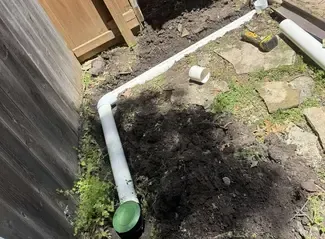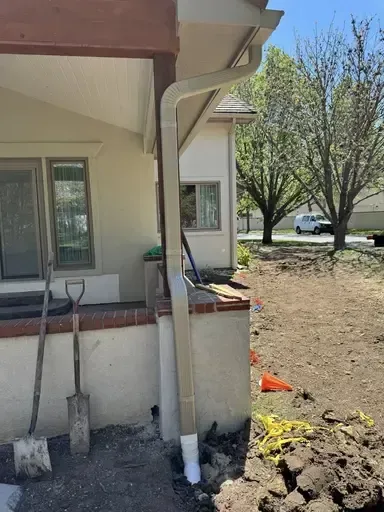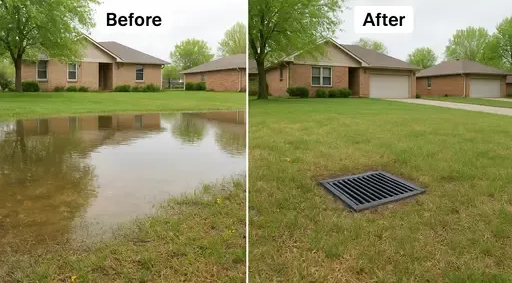Our Underground Downspout Installation Process
We follow a systematic approach for every underground downspout installation in Wichita. Our process ensures your system will drain properly, last for decades, and integrate seamlessly with your landscape. Here's exactly what happens when you work with us.
Property Assessment and Drainage Design
Before we dig a single shovel, we thoroughly evaluate your property. We walk around your home examining:
- How many downspouts you have and where they're located
- Where water currently goes and what problems it's causing
- The slope of your yard (even on flat Wichita lots, subtle grades exist)
- Soil type and drainage characteristics
- Underground obstacles like utility lines, sprinkler systems, tree roots
- Potential discharge locations that comply with local codes
- Your existing landscape features and hardscaping
We measure the roof area draining to each downspout so we can size pipes correctly. A downspout serving 1,200 sq ft of roof needs different capacity than one handling 400 sq ft.
We also locate underground utilities before digging. Kansas 811 markings show public utilities, and we use additional detection for private lines like irrigation, invisible fencing, or existing drainage. This prevents costly surprises mid-project.
By the end of our assessment, we've designed a complete system: where each line will run, how deep, what materials we'll use, and exactly where water will discharge. We create this plan based on proven engineering principles adapted to Wichita's unique conditions.
Trenching and Pipe Installation
Once you approve the design, we begin careful excavation. We hand-dig within a few feet of your foundation to avoid damage, then may use trenching equipment for longer runs across your yard.
Depth and Slope
We bury pipes deep enough to protect them but not so deep that slope becomes impossible on flat lots. Typical depth is 12-18 inches, though we go deeper if crossing under driveways or in areas prone to freezing.
The critical factor is slope. We maintain a minimum 1% grade (1 inch of drop per 10 feet of run) and prefer 2% when possible. Even though Wichita lots are often very flat, we carefully grade each trench to ensure water flows freely without any low spots where it could settle.
Pipe Material Choice
We primarily use two types of pipe for underground downspout lines:
Solid PVC (Schedule 40)
our premium recommendation. Smooth interior walls mean faster flow and less chance of clogs. PVC won't crush, doesn't corrode, and lasts 50+ years. It costs more but performs better.
Corrugated HDPE pipe
less expensive option that works well for many applications. The corrugated design gives flexibility for navigating around obstacles. We use it when budget is the priority and the site conditions are appropriate.
Both materials handle Wichita's freeze-thaw cycles without cracking when installed with proper slope for drainage.
Connection Points
We connect your downspouts to the underground line using purpose-built adapters. For added protection, we often install a catch basin or inline debris filter at this connection point to trap leaves and prevent clogs in the buried portion.
The pipes get bedded in gravel when needed for drainage and stability, then we carefully backfill trenches, tamping soil to prevent settling later.
Discharge Installation and Testing
Where your water goes is just as important as how it gets there. We create discharge points that comply with Wichita and Sedgwick County regulations while actually solving your drainage problem.
Pop-Up Emitters
Our most common residential solution. These low-profile green or black covers sit flush with your lawn. When water flows through, the top pops up to release it, then closes when flow stops. They keep debris and critters out while providing clean-looking discharge points in your yard or landscaping beds.
Bubbler Pots or Drywells
For areas where surface discharge isn't ideal, we can install bubbler pots (decorative rock-filled discharge points) or drywells (underground chambers that allow water to percolate into soil gradually).
Storm Drain or Curb Connections
When appropriate and permitted, we can connect your system directly to storm drains or route it to discharge at the curb. This requires proper permitting and inspection.
Daylight Discharge
On properties with slope toward the rear or side, we may run lines to "daylight" (discharge) in a low area, swale, or natural drainage area far from the house.
System Testing
Before we backfill and finish, we test everything. We run water from your roof through the gutters and downspouts to verify:
- Water enters the underground line properly
- Flow moves through the entire system without backing up
- No leaks at connections
- Discharge points work correctly
- No low spots where water could pool in the pipe
We also verify that during Wichita's heavy 3-4 inch rains, the system has capacity to handle peak flow. If we find any issues during testing, we correct them before completing the job.
Landscape Restoration
After testing confirms everything works perfectly, we finish the job:
- Backfill all trenches with removed soil
- Grade areas to match existing landscape contours
- Reseed disturbed lawn areas (or lay sod when requested)
- Replace mulch in landscaping beds
- Clean up completely—you won't even know we were there except for the new discharge points
Timeline
Most residential underground downspout installations take 1-2 days depending on how many downspouts we're connecting, how far the runs are, and whether we're integrating with other drainage systems. Complex properties with multiple discharge points or difficult terrain may take longer.
Our goal is a permanent buried downspout system that protects your foundation, eliminates drainage problems, and requires virtually no maintenance for decades. We don't consider the job complete until you're completely satisfied with both the function and the appearance.



